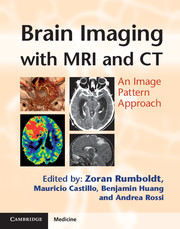Book contents
- Frontmatter
- Contents
- List of contributors
- List of abbreviations
- Preface
- Section 1 Bilateral Predominantly Symmetric Abnormalities
- Section 2 Sellar, Perisellar and Midline Lesions
- Section 3 Parenchymal Defects or Abnormal Volume
- 77 Hippocampal Sclerosis
- 78 Wallerian Degeneration
- 79 Rasmussen Encephalitis
- 80 Chronic Infarct
- 81 Post-Traumatic Atrophy
- 82 Postoperative Defects
- 83 Porencephalic Cyst
- 84 Schizencephaly
- 85 Hemimegalencephaly
- 86 Sturge–Weber Syndrome
- 87 Benign External Hydrocephalus
- 88 Normal Pressure Hydrocephalus
- 89 Alzheimer Disease
- 90 Frontotemporal Lobar Degeneration
- 91 Huntington Disease
- 92 Congenital Muscular Dystrophies
- 93 Dandy-Walker Malformation
- 94 Microcephaly
- 95 Hydranencephaly
- 96 Acquired Intracranial Herniations
- Section 4 Abnormalities Without Significant Mass Effect
- Section 5 Primarily Extra-Axial Focal Space-Occupying Lesions
- Section 6 Primarily Intra-Axial Masses
- Section 7 Intracranial Calcifications
- Index
- References
81 - Post-Traumatic Atrophy
from Section 3 - Parenchymal Defects or Abnormal Volume
Published online by Cambridge University Press: 05 August 2013
- Frontmatter
- Contents
- List of contributors
- List of abbreviations
- Preface
- Section 1 Bilateral Predominantly Symmetric Abnormalities
- Section 2 Sellar, Perisellar and Midline Lesions
- Section 3 Parenchymal Defects or Abnormal Volume
- 77 Hippocampal Sclerosis
- 78 Wallerian Degeneration
- 79 Rasmussen Encephalitis
- 80 Chronic Infarct
- 81 Post-Traumatic Atrophy
- 82 Postoperative Defects
- 83 Porencephalic Cyst
- 84 Schizencephaly
- 85 Hemimegalencephaly
- 86 Sturge–Weber Syndrome
- 87 Benign External Hydrocephalus
- 88 Normal Pressure Hydrocephalus
- 89 Alzheimer Disease
- 90 Frontotemporal Lobar Degeneration
- 91 Huntington Disease
- 92 Congenital Muscular Dystrophies
- 93 Dandy-Walker Malformation
- 94 Microcephaly
- 95 Hydranencephaly
- 96 Acquired Intracranial Herniations
- Section 4 Abnormalities Without Significant Mass Effect
- Section 5 Primarily Extra-Axial Focal Space-Occupying Lesions
- Section 6 Primarily Intra-Axial Masses
- Section 7 Intracranial Calcifications
- Index
- References
Summary
Specific Imaging Findings
Atrophy following traumatic brain injury can be divided into two types: focal atrophy and diffuse brain atrophy. Focal atrophy may manifest as either encephalomalacia or porencephaly. Characteristic locations for post-traumatic encephalomalacia parallel those of cortical contusions and include the orbitofrontal regions of the frontal lobes and the antero-inferior temporal lobes. Encephalomalacia can develop within weeks of the traumatic event, appearing as a relatively well-demarcated area of low density on CT with low T1 and high T2 signal on MRI, with associated parenchymal volume loss. Cystic replacement of brain parenchyma is occasionally seen on MRI. Areas of encephalomalacia are characteristically bordered by gliosis, which is also hypodense but usually of slightly higher attenuation on CT. Gliosis is best seen as a hyperintense rim adjacent to CSF-like hypointense encephalomalacia on FLAIR images.
Diffuse brain atrophy becomes evident months or years after brain trauma, even in relatively mild cases in which the initial imaging studies revealed no abnormalities. In these patients, delayed CT and MR imaging demonstrate first ventricular enlargement – particularly of the third ventricle and temporal horn, followed by diffuse widening of the cortical sulci and cerebellar fissures. Atrophy of corpus callosum is also a common finding. Diffuse post-traumatic volume loss in young children may develop at a very rapid rate, within days and weeks.
Information
- Type
- Chapter
- Information
- Brain Imaging with MRI and CTAn Image Pattern Approach, pp. 167 - 168Publisher: Cambridge University PressPrint publication year: 2012
